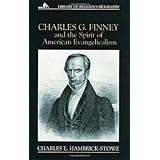
Average Reviews:

(More customer reviews)Charles G. Finney And the Spirit of American Evangelicalism By Charles E. Hambrick-Stowe
The book Charles G. Finney by Charles E. Hambrick-Stowe is a biography of an influential nineteenth-century Christian, Charles G. Finney. Hambrick-Stowe writes of the ways that Finney influence on the people brought forth the spirit of American evangelism. The author looks at Finney as a typical American, and as a Spirit filled believer mixed into one. One of the major themes in the book is how this complex man, Finney, managed to hold together the very different religious beliefs. These beliefs were of Presbyterian New School-Old School schism, and the Calvinist and Wesleyan versions of the Protestant gospel. Another theme is about the effectiveness of Finney ministry and his way of preaching. Before his conversion Finney was an apprentice to a lawyer, and Hambrick-Stowe points out how this had much influence on the way that Finney preached. Finney began his preaching career in and around New York after the first Great Awakening, and before the Civil War. According to Hambrick-Stowe's account of Finney's conversion and preaching ministry, was anything but traditional. Hanbrick-Stowe continually points out different times that Finny broke with the traditional ways of preaching and went on to forge new ways to evangelize the American people with much vivacity. Hambrick-Stowe did not believe that Finney started the Second Great Awakening, but he was a major contributor influenced by preachers from the Great Awakening. His critical thinking skills and the poor preachers that he heard before his conversion helped strengthen his conviction to present the gospel with furor.Hambrick-Stowe makes Finney out to be the spark that lit the fire of evangelism. Because there was much turmoil in the church, and a lack of enthusiasm in preaching, Finney's style spoke directly to the people and brought on deep conviction of even the hardest critic. People responded to Finney's preaching because he used whatever method was necessary for the congregation. The greater the crisis in the community where Finney preached, the greater the response to the Holy Spirit. If a town or city were experiencing turmoil in any sense of the word, they would look to religion to lighten the burden of the social and economic status. Finney used this to his advantage in the pulpit. Hambrick-Stowe lets the reader believe that another reason for the effectiveness of Finney's preaching is due to Finney's personal interest in the people Spiritual wellbeing. In his ministry, Finney would go to different people's house to talk to them on a personal level, and to get a better understanding of them. He would talk to the local authorities and the religious leaders as well. Finney would encourage people to pray for the ministry, for penitents to give their lives to Christ, and for those who had special needs to come up to the front to be prayed for. Hambrick-Stowe tells us that another factor that contributed to Finney's influence was his message for all peoples regardless of age, race, or sex. Even during a time of heated theological debate between the denominations, Finney brought harmony where there was discord between people. Finney's role in the time was of a person who led the way for a new means of revival that continue today. His idea's of salvation for all persons was a new idea after the puritan and Calvinistic ideas of predestination. Finney encouraged door-to-door evangelism, personal testimonies in a service, and even women's testimonies. This is a good educational book.
Click Here to see more reviews about: Charles G. Finney and the Spirit of American Evangelicalism (Library of Religious Biography Series)

No comments:
Post a Comment